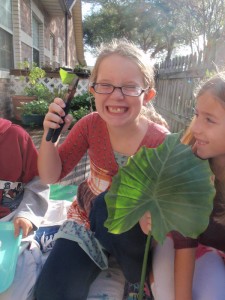The Nature-Study Movement

Originally appears in the Spring 2013 issue
Every first year teacher has a big learning curve, and my first class 12 years ago taught me that keeping alive the children’s senses of wonder and connection to their natural world is just as important as teaching reading and math. I was astounded at how disconnected my first and second graders were from the food in their lunch boxes and the natural world outside their doors. Through a small schoolyard garden, I made it my mission to show them, and the classes that followed, the wonders of a seed, the fun of harvesting and cooking greens. I also wanted them to know how delicious a tomato picked and eaten fresh off the vine could be.
I had a strong connection to gardening and nature while growing up. As a child, picking and planting was all in good fun, but as I look back I understand on a deeper level the connections to nature, wonder, beauty, and food that were being built. There was never any fuss over eating vegetables in my house because they were homegrown and delicious! I had a connection with the food and the people who grew it. These childhood nature experiences were the foundation for my adult desire to create school and children’s gardens.
Nature-Study and School Gardens: Yesterday and Today
A few years ago I discovered the Nature-Study movement, which although I didn’t realize it at the time, had been influencing my teaching style and work connecting children and nature for years. This influential movement sustained mainstream popularity from the late 1800s through the early 1920s and promoted a conservation ethic in children through education and primary experience in and with nature. The Nature-Study movement encompassed various themes: the sentiment of nature versus the science of nature; an integration of gardens in schools; the popularizing of the belief that humans, and especially children, have a natural inherent connection with nature; the promotion of conservation awareness; and the concept of nature’s intertwined relationship with aesthetics and art.
To view the photo-rich magazine version, click here.
If you are not already a subscriber, please subscribe to read the full article
Kelly Johnson is an auxiliary teacher at Montessori Tides School in Jacksonville Beach, Florida when not travelling to conferences and book promotions. She is the author of Wings, Worms, and Wonder: A Guide for Creatively Integrating Gardening and Outdoor Learning Into Children’s Lives from which the activities and ideas in this article were drawn . Signed copies of this engaging book can be purchased from the author at www.wingswormsandwonder.com.
Leave a Reply
You must be logged in to post a comment.





